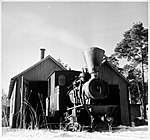Borgholm – Böda railway line
| Borgholm – Böda | |||||||||||||||||||||||||||||||||||||||||||||||||||||||||||||||||||||||||||||||||||||||||||||||||
|---|---|---|---|---|---|---|---|---|---|---|---|---|---|---|---|---|---|---|---|---|---|---|---|---|---|---|---|---|---|---|---|---|---|---|---|---|---|---|---|---|---|---|---|---|---|---|---|---|---|---|---|---|---|---|---|---|---|---|---|---|---|---|---|---|---|---|---|---|---|---|---|---|---|---|---|---|---|---|---|---|---|---|---|---|---|---|---|---|---|---|---|---|---|---|---|---|---|
|
Borgholm Railway Station, 1947
| |||||||||||||||||||||||||||||||||||||||||||||||||||||||||||||||||||||||||||||||||||||||||||||||||
|
Station building in Borgholm
| |||||||||||||||||||||||||||||||||||||||||||||||||||||||||||||||||||||||||||||||||||||||||||||||||
| Route length: | 55 km | ||||||||||||||||||||||||||||||||||||||||||||||||||||||||||||||||||||||||||||||||||||||||||||||||
| Gauge : | 891 mm ( Swedish 3-foot track ) | ||||||||||||||||||||||||||||||||||||||||||||||||||||||||||||||||||||||||||||||||||||||||||||||||
| Maximum slope : | 10 ‰ | ||||||||||||||||||||||||||||||||||||||||||||||||||||||||||||||||||||||||||||||||||||||||||||||||
| Minimum radius : | 300 m | ||||||||||||||||||||||||||||||||||||||||||||||||||||||||||||||||||||||||||||||||||||||||||||||||
| Top speed: | 35 km / h | ||||||||||||||||||||||||||||||||||||||||||||||||||||||||||||||||||||||||||||||||||||||||||||||||
|
|||||||||||||||||||||||||||||||||||||||||||||||||||||||||||||||||||||||||||||||||||||||||||||||||
The Borgholm – Böda railway was a 55 km long narrow-gauge railway between Borgholm and Böda on Öland in the province of Kalmar Lan with a gauge of 891 mm. It was built by Borgholm – Böda Järnvägsaktiebolaget (BBJ) and inaugurated on December 7, 1906.
On January 1, 1928, the Borgholm – Böda Järnvägsaktiebolaget was combined with the Södra Ölands Järnväg to form the Ölands Järnvägar (SÖJ). It was shut down in 1961.
history
Borgholm – Böda Järnvägsaktiebolaget
The Borgholm – Böda Järnvägsaktiebolaget (BBJ) received its concession on December 11, 1903. The company received a state grant of 175,000 crowns . The municipalities subscribed to shares amounting to 206,700 kroner, of which Borgholm accounted for 121,700 kroner. Individually subscribed shares accounted for 40,650 kroner. A public loan was taken out in the amount of CZK 419,000.
The offer for the construction of the line amounted to 207,000 crowns. A turntable for turning the steam locomotives was set up in Böda and Borgholm. In October 1905 the provisional freight traffic from Borgholm to an unknown end point was taken up, in April 1906 Böda was reached with the provisional freight traffic. The first train ran on December 1, 1906 and the line was inaugurated on December 7, 1906.
At the time of construction, the company was planning to transport wood from Böda Kronopark to the north. However, as the state built a port and a sawmill in Grankullavik in the Grankullaviken Bay , the timber transport failed.
The economic situation of the company got worse and worse, so that the board members had to pay a deposit. It was streamlined very soon and the BBJ was one of the pioneers in hiring low-paid female railroad workers. It was difficult to get the churches to raise more money. The joint debt of BBJ and the second company on the island, Södra Ölands Järnväg (SÖJ), amounted to almost 1.4 million crowns in 1927. Only the SÖJ paid interest.
In 1927, the Reichstag decided to write off the loan down to 800,000 kroner. The remainder should bear no interest for three years and half interest for another two years. The condition for this was that BBJ and SÖJ should be merged. On January 1, 1928 the business was taken over by the newly formed company Ölands Järnvägar .
This in turn was taken over by Statens Järnvägar as part of the general nationalization of the railway in 1947 .
vehicles
Three tank locomotives from Orenstein & Koppel were imported from Germany for operation .
| number | Surname | design type | Wheel alignment | Manufacturer | Construction year | Whereabouts |
|---|---|---|---|---|---|---|
| 1 | BÖDA | Tank locomotive | 1 B t | Orenstein & Koppel , Berlin | 1567 1905 |
January 1, 1928: ÖJ 7; K3t 4050 , retired in 1945 |
| 2 | BORGHOLM | Tank locomotive | 1 B t | Orenstein & Koppel, Berlin | 1568 1905 |
January 1, 1928: ÖJ 8; Scrapped in 1947 |
| 3 | (THE EMPEROR) | Tank locomotive | 2 B t | Orenstein & Koppel, Berlin | 1847 1906 |
January 1, 1928: ÖJ 9; 1947: SJ W3p 3059 , retired in 1953 |

|

|
|
|
O&K locomotive No. 1, Böda
|
O&K locomotive No. 2, Farmor
|
48 two-axle freight cars, two bogie passenger cars, three two-axle passenger cars and two mail cars were procured. The cars were made by Fole Mekaniska Verkstad from Gotland.
See also
Web links
- Rolf Sten: Borgholm - Böda Järnväg. In: historiskt.nu. September 28, 2002, Retrieved October 4, 2019 (Swedish).
- Kjell Byström, Rolf Sten: Borgholm – Böda järnväg (BBJ), Bandel 667. In: historiskt.nu. June 30, 2015, Retrieved October 4, 2019 (Swedish).
- Böda – Borgholm. Bandel 667, SJ district 27 bs. In: banvakt.se. Retrieved October 4, 2019 (Swedish).
- Borgholm - Böda Järnväg. In: historiskakartor.lantmateriet.se. Retrieved October 4, 2019 (Swedish).
- History. In: olandsjarnvag.org. Retrieved October 4, 2019 (Swedish).
Individual evidence
- ↑ Borgholm-Boda järnväg . In: Theodor Westrin, Ruben Gustafsson Berg, Eugen Fahlstedt (eds.): Nordisk familjebok konversationslexikon och realencyklopedi . 2nd Edition. tape 34 : Supplement: Aa – Cambon . Nordisk familjeboks förlag, Stockholm 1922, Sp. 745-746 (Swedish, runeberg.org ).
- ↑ Gunnar Eveking: Ekeving Bangårdsskisser Öland. Archived from the original on December 29, 2014 ; Retrieved October 4, 2019 (Swedish).
- ↑ a b Kjell Byström, Rolf Sten: Borgholm – Böda järnväg (BBJ), Bandel 667. In: historiskt.nu. June 30, 2015, Retrieved October 4, 2019 (Swedish).
- ^ Rolf Sten: Borgholm - Böda Järnväg. In: historiskt.nu. September 28, 2002, Retrieved October 4, 2019 (Swedish).
- ^ Borgholm - Böda Järnväg (BBJ). In: pospichal.net. Retrieved October 5, 2019 . - different information from: Ångloken. In: olandsjarnvag.org. Retrieved October 5, 2019 (Swedish).
- ↑ Fredrik Anderson: Ölands Järnväg - En tillbakablick. Retrieved October 4, 2019 (Swedish).
Coordinates: 56 ° 52 ′ 55.2 " N , 16 ° 39 ′ 23.8" E


